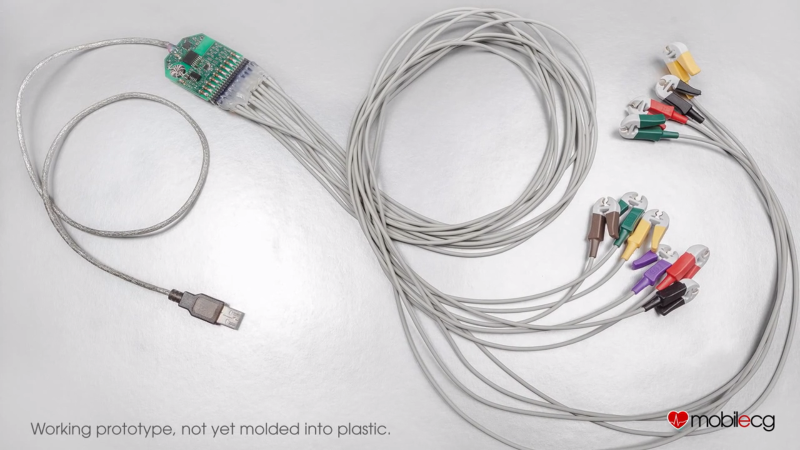After a failed crowdfunding campaign, MobilECG has gone open source. MobilECG is a medical grade 12 lead electrocardiograph. A 12 lead system is quite a bit more complex than some of the ECG systems we have featured in the past. [Péter], the founder and designer of the device attempted to fund it through an Indiegogo campaign. While MobilECG is relatively cheap, medical certifications are not. The campaign didn’t reach its goal of $230,000 USD. [Péter] tried again with a grass-roots donation round at his website. That round also fell short of [Péter’s] goal to keep working on the project. Rather than let his hard work go to waste, [Péter] has made the decision to release his hardware and software to the community. The hardware is licensed under CERN OHL v1.2. The software is released under the humorously named WTFPL.
While we’re not ECG experts, the basic hardware design appears to be sound. MobileECG is based around the Texas Instruments ADS1278 octal analog to digital converter. Two AVR microcontrollers are used, an ATTiny24, and an ATUC64. The analog design incorporates such niceties as lead off detection and defibrillator protection. It should be noted that there are some known bugs in the design, [Péter] mentions he can be contacted with questions. The software seems to be in an early state, and would require quite a bit of work to get it to a final design. While we do wish [Péter] had better luck with his campaign, we’re always glad to see designs released into the open source community.
















Very nice design. Just wondering why they used a general purpose ADC instead of something like a specific ECG Front End (like the ADS 1198 or ADS 1298)
easy: money.
According to TI’s website, the price for an ADS1278 (the one they used) is $25.15 and the price for an ADS1298 (ECG Analog Front End) is $23.95, both in large T&R, 1K units.
Today everyone can buy very cheap wired ECG instruments all over the world. It’s a waste of time, believe me. But if you really have the knowledge to develop medical instruments then make a wireless one with a stable and real-time connection!
no, 12 channel ecg’s are very very expensive, real-time 12 channel ecg’s started at 1500-2000usd
But who should buy a such ECG? 12-channels means that a professional is going to use it, right?! So let’s start a short calculation:
$1500 : 10 = $150 per year if you going to use it over 10 years
$150 : 220 = $0.68 per working day
That’s peanuts if you bring it to correlation with all costs of an examination like disposable electrode pads, staff, consultation, rent, furniture etc.
And even if you would be able to bring the ECG instrument to one-tenth, it’s still not relevant to the total costs of an examination and don’t forget that the Software is key!
Please don’t get me wrong, I like the idea in general, but again, where is the market for that product?! Third World Countries? We are just talking about the diagnosis. Who will pay for the surgery and for a pacemaker and the annual checks for the patient?
Try instead to build the best cost-effective wireless real-time ECG in the world and I’m with you!
It’ll be interesting to see where it goes with the more or less (more than less) stillborn AVR32.
I think in some countries it is best to combine the WTFPL with a disclaimer, otherwise you may still be liable for misuse by a third party or damages caused by your software.
I think he should just use the MIT license. It’s basically just what he has, plus the disclaimer.
I’m glad he decided to share the project, instead of throwing it away.
Thanks for sharing this project! As long as it was only battery operated and not hooked to any mains while it is operated, it would be as safe as any phone or cd player that people carry around with wired speakers hooked across the brain in the ears.
Unlike the devices you named, an ECG has a low-resistance current path across the heart. Even a battery-powered device can do real damage with that. Making a safe ECG is more complicated than just sticking batteries in it, and a properly designed and isolated ECG is safe regardless of where it gets its power.
Did any one try to compile it up ? that is does this project actually works ??